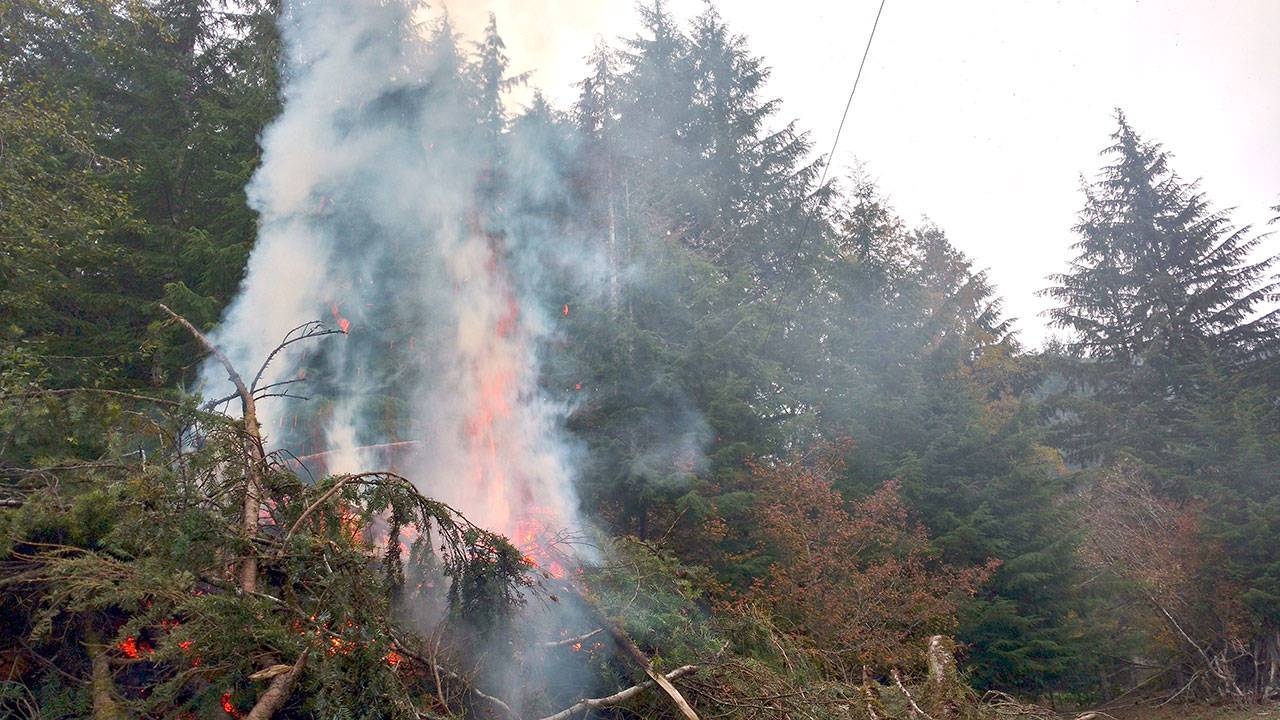WHEN THE 124-FOOT hemlock fell with its top right in the fire, it could not have been more perfect.
The evening was fairly dark, much too dark to be messing with chainsaws, fire and falling trees, but the sparks from a home slash pile are best seen with dark skies.
Earlier in the summer, my husband, Dennis, and I had discussed the fate of a couple of trees on our property.
One was a Douglas fir that had been looking more and more sickly as the years passed. The other was a hemlock that was high-rooted on a stump that had died so long ago it wasn’t even visible anymore.
Both trees were well over 100 feet in height and fully capable of smashing stalls and the animals finding refuge in them if they were to fall on their own. The first tree Dennis felled was the fir and he bucked the trunk to lengths for possible sale to a mill in the future.
The limbs were piled by hand into a stack that was around 10 feet in height.
Slash piles are a common sight after a forest unit has been logged.
Land managers have equipment operators use their machines to pile remaining limbs and tops after all merchantable timber has left the site.
This only happens for timber sales on fairly level ground as shovels and loaders are unsafe for gathering sticks on steeper hillsides. The piles wait until the fall rains arrive to be set on fire.
Part of West End reforestation includes setting these piles on fire and years ago I spent a season setting slash piles ablaze. Those mornings began at daylight with the crew driving out to the site in a van that held six five-gallon propane tanks in the back, tanks just like you see under barbecues and in front of travel trailers.
We each grabbed a tank with a brush torch fitted on it.
Stepping off the gravel road, we took our tanks and torches out to the piles, one person per pile.
Walking around the pile would usually reveal some nook that allowed the flaming torch to be pushed under the belly of the mountain of sticks.
At first, the torch makes only weak gray smoke while the moisture in the wood steams, but when the smoke turns a billowy olive-green, then one can be sure the fire is actually burning wood.
Burning season is relatively short, lasting around a month or so and the smell of autumn slash piles burning is a pleasant odor, far from the suffocating smoke of summer wildfires.
So last week when the air carried wafts of slash pile smoke, my husband and I began to itch over setting our own pile on fire. We had been waiting for some real West End rain and finally, the weather forecast was favorable.
The hemlock was leaning in the worst direction possible, so about a month ago, my husband had taken much of the weight off the trunk by removing all the limbs up to about 80 feet. He also affixed a long section of haywire to the top and anchored it just to be sure it would not fall the wrong way in windy weather.
While he was up in the tree, he had the cool idea to drop the tree top into the slash pile.
One afternoon last week, I lit the pile with old newspapers and boxes. It wasn’t long after my husband got home from work and we soon had plumes of olive-green smoke billowing from the pile.
The sun was setting so we had to act fast. We decided at the last minute to move the horses and goat closer to our house. The animals looked at us like we had lost our minds because it was their dinner time — absolutely not the time to present them with confusing requests.
While I wrangled the critters, Dennis set a block up in another tree and ran the haywire through it. He moved my Jeep into position and attached the end of the haywire to the trailer hitch.
When he went to cut the hemlock, it was too dark to read.
By the time he began the back cut, every car going by on the highway had their headlights on. Sitting in the Jeep, keeping tension on the haywire, I couldn’t even see him at the base of the tree.
Darkness had settled in, but this was no time to stop even though we can never seem to find a working flashlight when we need one.
Seeing the silhouette of the tree moving in the right direction against the dark sky was a huge relief because a foolhardy job in the dark was going to end all right.
When the hemlock top with all of its limbs hit the fire, it seemed to put the flames out. In one breath, the needles caught fire and the flames roared to life again.
We pulled the truck around, opened the doors and listened to music while we celebrated the fire, watching the sparks fly heavenward in the rainy night sky.
_________
Zorina Barker has lived on the West End for most of her life. She is married to a Forks native who works in the timber industry. Both of her kids have been home-schooled in the wilds of the Sol Duc Valley. She can be reached at 360-461-7928 or zorinabarker81@gmail.com.
West End Neighbor appears in the PDN every other Tuesday.
Her next column will be Nov. 13.

